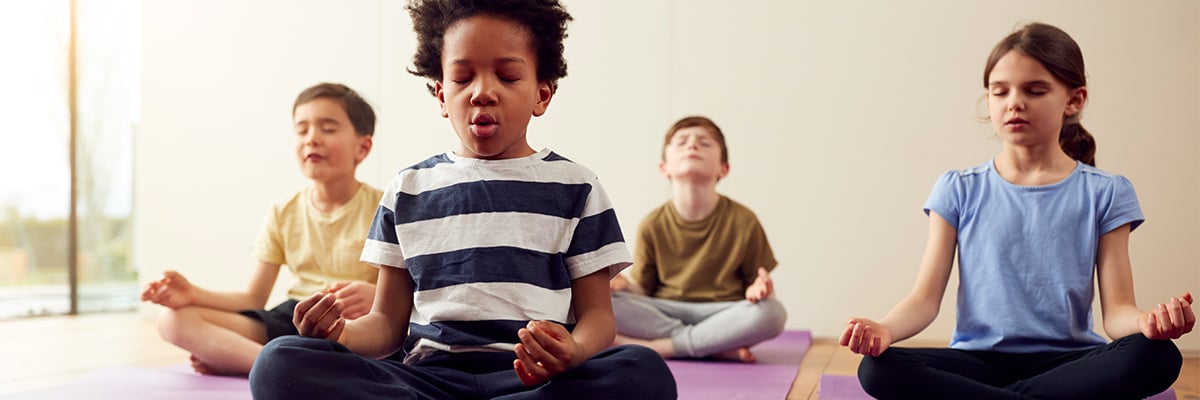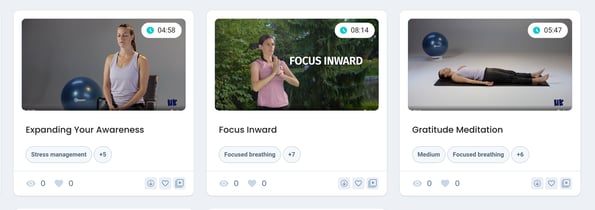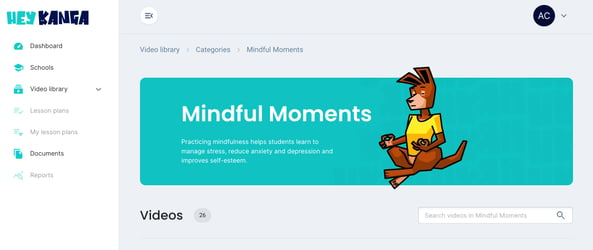Mindfulness for Kids - The Ultimate Guide

Practising mindfulness is becoming increasingly popular in our modern age. You might think it’s just a buzzword, but it’s so much more than that. It is a fantastic practice to remedy/reduce stress, restlessness and lack of concentration and boost overall well-being. But while there is an abundance of resources on the benefits of mindfulness for adults, there is little guidance on mindfulness for kids. Well, we’re here to offer parents, caregivers and teachers an ultimate guide to mindfulness for kids!
What is mindfulness?
using techniques that encourage/enable someone to pay attention to the present manner with an accepting and open perspective
Mindfulness can look different for everyone, but it boils down to: using techniques that encourage/enable someone to pay attention to the present manner with an accepting and open perspective. For one person, this may look like meditation or breathing exercises, for someone else it may look like doing a soothing activity, such as gardening. Why is mindfulness important? Practising mindfulness helps promote happiness and decrease feelings of anxiety and overwhelm. It’s great for children, as it helps them learn how to stay present, navigate overwhelming situations and accept new and unfamiliar situations.
Mindfulness for kids
Is there a ‘right’ age for children to practise mindfulness?
Children of all ages can benefit from mindfulness. Understandably, it may be more difficult for younger children to engage and participate in some mindfulness practices, but adopting a gentle and positive attitude to the present moment is a wonderful habit for children to form.
In fact, forming a habit, such as mindfulness, during children’s developmental stage will help inform adult behaviour. Prefrontal circuits in our brain are created quickly during childhood. As mindfulness promotes skills that are controlled in the prefrontal cortex - focus and concentration - it will impact the development of other skills, such as self-regulation, judgement and patience during childhood.
Benefits
Mindfulness in children has been found to improve cognitive control, working memory and even the ability to solve maths problems. These cognitive abilities aid in the development of more advanced skills, such as problem-solving, planning, reasoning and forming social relationships. For children with ADHD, mindfulness can reduce a child’s aggression, anxiety and stress.
Studies show that mindfulness can improve academic performance in students. Overall, teaching mindfulness to kids will help them cope with overwhelming feelings and sensations, and relate to uncomfortable and challenging moments from a place of acceptance. Adopting a mindful approach in the classroom will help pupils create a calm, positive-learning environment.
Mindfulness in children has been found to improve cognitive control, working memory and even the ability to solve maths problems.
Ideas on how to implement mindfulness inside and outside the classroom
You’ve probably heard the expression ‘children are like sponges’ before. Well, there is truth behind it! Infants especially observe and absorb everything caregivers do, so the best way to teach and encourage mindfulness is to embody it. Simply put, lead by example. One simple way to do this is to put down your phone and smile at your child and ask them a question. This behaviour will help both caregiver and child a chance to connect and engage with each other in the present moment.
Home is a great place to start when teaching your child about mindfulness. Here are some techniques you can do with your children:
If you or your child are feeling frustrated, a good mindfulness technique to use is ‘S.T.O.P’.
S.T.O.P. Method
Stop and pause. Take a momentary break from whatever you’re doing.
Take a breath and bring your awareness and attention to your breathing.
Observe and focus on what is happening externally and internally.
Proceed. Having taken a moment to be in the present, continue with what you’re doing.
Another simple technique for mindfulness for kids and parents is movement. Going for a walk and doing yoga are great ways to focus your mind on your body and the present moment.
For children who are able to talk or are learning to talk, this is a great exercise to not only practise mindfulness but also adopt a grateful attitude and perspective.
Being mindful is not about pretending bad things aren’t happening or repressing negative feelings; instead it’s about adopting a new outlook. This new perspective will help you navigate situations from a place of calm. The 1-3 method is great for this.
1-3 Method
For every negative thing happening in your life, think of three good things. Think about the people you love, a cuddly pet or something kind a stranger did for you (or vice versa – you might have made someone’s day). Share your thoughts with someone you trust and care about. Voicing your gratitude will make the positive side effects stronger.
Important! Remember to use mindfulness and gratitude techniques in a variety of situations, as often as possible. If techniques are only used in times of trouble, they become less effective and you or your child might begin to associate them with negativity.
It’s important for all of us to explore sensations that arise without judgement - these can be pleasant, neutral or unfamiliar.
To help children express how they’re feeling, try this R.A.I.N. exercise.
R.A.I.N. Exercise
Recognise and acknowledge what is happening and make a note of any sensations in an accepting manner.
Accept and let things be. Allow life to be as it is.
Investigate and be inquisitive about how you feel. Note whether things happening in the present are causing pain, or bringing joy.
Non-identification. Understand that feelings and sensations are fleeting and will pass, and they do not make you who you are.
Remember! Practice is key. Make mindfulness part of your routine to really realise the benefits.
Belly breathing
This is a well-known breathing technique that will help children focus on their breathing and shift their awareness to their bodies.
Follow these steps to do belly breathing:
When taking an inhaling breath, notice how your tummy expands and rises. When you exhale, your tummy falls. For 5 breaths focus on your tummy rising and falling as you breathe, then return to normal breathing.
Mindfulness in schools
The methods mentioned above can be used in and out of school. By implementing mindfulness in the classroom you can help students deal with adversity and deepen their understanding of the world around them, as well as about themselves.
To help you practise mindfulness with your pupils, Hey Kanga has adapted mindfulness activities for the classroom.
Mindfulness for kids with Hey Kanga
Here at Hey Kanga we believe in the power of mindfulness. We also believe in nurturing and strengthening the connection between body and mind. That’s why we have an extensive library full of exciting and easy-to-use resources to get children moving.
In our video library you’ll find YouTube videos or full playlists about mindfulness activities for kids.

These videos will make it easy for you and your class to follow a mindfulness technique. They can be used as a short brain break, or as a warm up or warm down during a PE lesson.
You could get your pupils doing yoga with our fantastic yoga tutorials and lesson guides! Yoga is a great way to introduce children to mindfulness, as it encourages deep, mindful breathing and gentle movements to ground and centre.
Sign up for a FREE TRIAL to start incorporating mindful moments into your class


